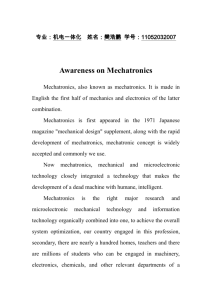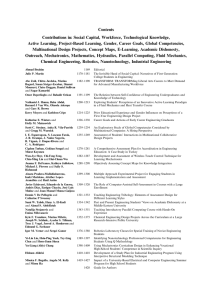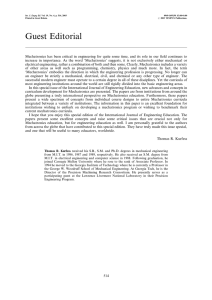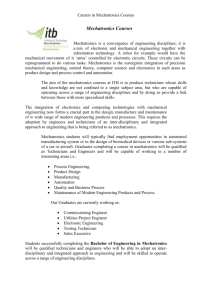Mechatronics Education at the Johannes Kepler University: Engineering Education in its Totality*
advertisement
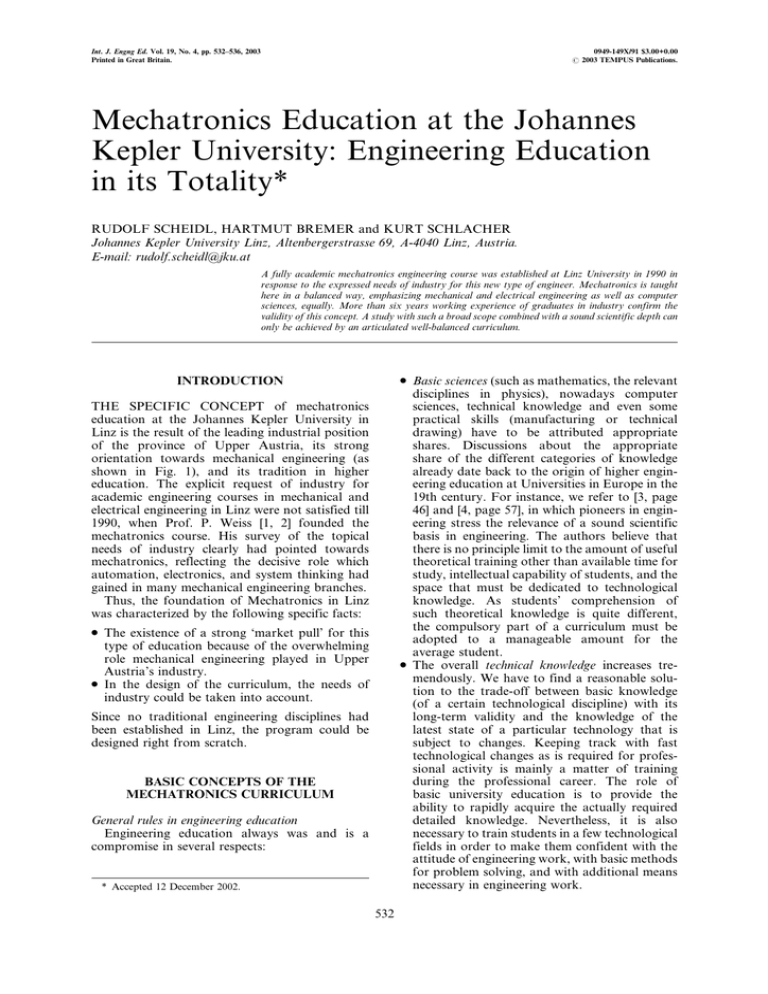
Int. J. Engng Ed. Vol. 19, No. 4, pp. 532±536, 2003 Printed in Great Britain. 0949-149X/91 $3.00+0.00 # 2003 TEMPUS Publications. Mechatronics Education at the Johannes Kepler University: Engineering Education in its Totality* RUDOLF SCHEIDL, HARTMUT BREMER and KURT SCHLACHER Johannes Kepler University Linz, Altenbergerstrasse 69, A-4040 Linz, Austria. E-mail: rudolf.scheidl@jku.at A fully academic mechatronics engineering course was established at Linz University in 1990 in response to the expressed needs of industry for this new type of engineer. Mechatronics is taught here in a balanced way, emphasizing mechanical and electrical engineering as well as computer sciences, equally. More than six years working experience of graduates in industry confirm the validity of this concept. A study with such a broad scope combined with a sound scientific depth can only be achieved by an articulated well-balanced curriculum. . Basic sciences (such as mathematics, the relevant disciplines in physics), nowadays computer sciences, technical knowledge and even some practical skills (manufacturing or technical drawing) have to be attributed appropriate shares. Discussions about the appropriate share of the different categories of knowledge already date back to the origin of higher engineering education at Universities in Europe in the 19th century. For instance, we refer to [3, page 46] and [4, page 57], in which pioneers in engineering stress the relevance of a sound scientific basis in engineering. The authors believe that there is no principle limit to the amount of useful theoretical training other than available time for study, intellectual capability of students, and the space that must be dedicated to technological knowledge. As students' comprehension of such theoretical knowledge is quite different, the compulsory part of a curriculum must be adopted to a manageable amount for the average student. . The overall technical knowledge increases tremendously. We have to find a reasonable solution to the trade-off between basic knowledge (of a certain technological discipline) with its long-term validity and the knowledge of the latest state of a particular technology that is subject to changes. Keeping track with fast technological changes as is required for professional activity is mainly a matter of training during the professional career. The role of basic university education is to provide the ability to rapidly acquire the actually required detailed knowledge. Nevertheless, it is also necessary to train students in a few technological fields in order to make them confident with the attitude of engineering work, with basic methods for problem solving, and with additional means necessary in engineering work. INTRODUCTION THE SPECIFIC CONCEPT of mechatronics education at the Johannes Kepler University in Linz is the result of the leading industrial position of the province of Upper Austria, its strong orientation towards mechanical engineering (as shown in Fig. 1), and its tradition in higher education. The explicit request of industry for academic engineering courses in mechanical and electrical engineering in Linz were not satisfied till 1990, when Prof. P. Weiss [1, 2] founded the mechatronics course. His survey of the topical needs of industry clearly had pointed towards mechatronics, reflecting the decisive role which automation, electronics, and system thinking had gained in many mechanical engineering branches. Thus, the foundation of Mechatronics in Linz was characterized by the following specific facts: . The existence of a strong `market pull' for this type of education because of the overwhelming role mechanical engineering played in Upper Austria's industry. . In the design of the curriculum, the needs of industry could be taken into account. Since no traditional engineering disciplines had been established in Linz, the program could be designed right from scratch. BASIC CONCEPTS OF THE MECHATRONICS CURRICULUM General rules in engineering education Engineering education always was and is a compromise in several respects: * Accepted 12 December 2002. 532 Mechatronics Education at the Johannes Kepler University 533 Fig. 1. Industrial production in Upper Austria in 1995 (Upper Austria shares 16% of Austria's population). . Engineering education should also provide some knowledge in economics and management. First, the engineer must be aware that economic aims and constraints are part of his work. Second, for certain types of jobs he needs some elementary knowledge in business sciences. Mechatronics is a change of paradigms, both in the design of certain technical systems in (industrial) practice and in engineering education. We see the following main (partly trade-off) problems in the design of a mechatronics curriculum. The `start problem' and long-time perspectives In mechatronics education the problem of the tremendous increase of technical knowledge is resolved by a concept which might be called `laying foundations'. Basically, these foundations are all the knowledge and abilities the graduate needs in order to start a career and he can improve by training on his job by life-long learning. A graduate from a mechatronics course will quite often start his career complying with existing job profiles, in which he is expected to perform comparable to graduates of classical engineering disciplines. Is this realistic? It is, if the particular knowledge required to master such first tasks can be acquired efficiently from literature, company documents, and know-how transfer from experienced colleagues. A sound physical background, an engineering attitude towards problem solving, asking the right questions, working systematically, clear documentation (reporting) of work and results, creativity in solution finding, effective and efficient communication with others are important for success in this phase. Such abilities are typically requested in R&D work. But there are many other positions young engineers might start at: as a sales engineer or for the engineering of machine systems. Primarily, such work needsÐbesides the sound understanding of a given technical systemÐcommunication and administration. In small and medium enterprises (in short SMEs) engineers generally have a broader job profile than research people in a big company. Nonetheless, even engineers in SMEs should be able to go into depth if necessary, for instance, when co-operating with experts of a research institute. A mechatronics education should meet these needs quite exceptionally. Graduates from the University should also act as `technology pushers', both on a short and on a long time basis. There is always some sort of new technology or scientific method which the young graduate can introduce to a company. Nowadays, this typically regards to computing in some way. The long time aspect is related to the engineer's ability to keep pace with the technological development. The broad education stressing the foundations and some scientific curiosity are the best basis for that. Unifying view and modeling Modeling is basic for the understanding and quantitative analysis of technical systems. Unfortunately, no clear rules exist what foundations and what models are most relevant. Every engineering discipline has worked out its own treatment of the relevant physical knowledge, e.g. technical mechanics in mechanical engineering or the theory of electricity in electrical engineering. Part of this specialized knowledge can be omitted today due to powerful modeling and simulation methods enabled by the enormous performance of computers. In other words, we can replace many specialized methods by a few general methods. But we cannot go too far. As an example we mention beam theory in mechanics. Nowadays, it could easily be replaced by a much more refined analysis of the three dimensional problem by using Finite Element Analysis. But the comprehensive insight provided by adequate models of beam theory will remain indispensable, particularly in the conceptual design phase. There are attempts to unify modeling in mechatronics, e.g. [5], mostly promoted by people engaged in the simulation of discrete dynamical systems. Despite the outstanding 534 R. Scheidl importance of such models in studying mechatronic systems it should not dilute the physical differences of the various engineering disciplines which are reflected by the different nature of mathematical models. Although we don't recommend an exceptional unified modeling approach, we stress a teaching attitude towards `thinking in models'. This should incorporate the ability to set up models, to know the qualitative solution of at least some generic cases and ways for obtaining quantitative solutions by at least numerical methods. Width of technical knowledge versus depth What is pointed out in Section 2.1 for engineering education in general is particularly relevant in mechatronics. Manufacturing technology and knowledge of the manifold technical systems can only be given as an overview. Details must be learned in practice. Design education Design is a big challenge in any type of engineering education. Although successful design in industry is the result of proper product planning, creativity, experience, and physical and technological knowledge, proper education plays an important role. We can neither create the experienced designer at the University nor will we make everyone of our graduates a successful designer. However, we have to promote design as a crucial part of successful product development and we should motivate those who have the proper talents by challenging design projects. Mechatronic aspects should be included in this project work. THE NEW CURRICULUM OF MECHATRONICS AT LINZ UNIVERSITY The structure of the curriculum Austrian law concerning academic engineering courses currently offers the choice either to Table 1. Plan of the proposed mechatronics curriculum 1st TERM (Semester 1 and 2) SWHa Course Mathematics I Mathematics II 5 1E 5 1E Technical Mechanics I Technical Mechanics II 4 2E 3 2E Material Science 2 SWHa Course Technical Computer Sciences I Programming I Algorithms I Data Structures I Electrical Engineering I 2 1E 1 2E 2 1E 2 1E 3 2E 2nd TERM (Semester 3 to 7) Ordinary Differential Equations System Theory 3 1E 2 1E Technical Computer Sciences II Programming II Algorithms II Data Structures II 2 1E 1 2E 2 1E 2 1E Technical Mechanics III Workshop in Manufacturing Processes Introduction to Mechanical Engineering Machine Elements I Machine Elements II Thermo- and Fluiddynamics Machine Dynamics 3 1E 2L 2 2E 2 2E 2 2E 3 2E 2 1E Electrical Engineering II Workshop in Electrical Engineering Electrical Engineering Lab Electrical Measurement- and Sensor Technology Semiconductor Devices and Circuits Communications Engineering Electrical Drives Technology I Technical Electronics 3 2E 2L 3L 3 2E 3L 2 1E 2 1E 2 1E 2 1E Feedback Control Systems I Feedback Control Systems II Feedback Control Syst. Lab 2 1E 2 1E 3L Analysis of Mechatronic Systems Design of Mechatronic Systems 2 2L 2S 3 2 1E 3L Computer Aided Methods in Mechanics Project Seminar Diploma Thesis 2 6P 3rd TERM (Semester 8 to 10) Numerical Analysis Electrical Drive technology II Elective groups 40 SHWs in total; 20 SHWs from one (the main) group; remaining from any group Drive technologies Electrical Measurement Technology and Signal Processing System Analysis and ±optimization Mechatronic Design Communications Engineering a Automation and Robotics Computer Sciences in Mechatronics Microelectronics Mechanics of Solids and Fluids Mathematical and Scientific Methods in Mechatronics 2 1E 2L: 2 SWHs lectures, 1 SWH exercises, 2 SWHs laboratories; S: seminar; P: project seminar Mechatronics Education at the Johannes Kepler University preserve the classical style (which was typical for Middle European Universities of Technology) leading to a master's degree or to adopt to the new European guidelines leading to a bachelor degree first. The total duration of study amounts to 10 semesters (master's degree) and the amount of all lessons can range from 160 to 210 so-called semester week-hours (SWH). One SWH is a unit of 45 minutes per week of a semester, which typically lasts 15 weeks. The `study commission' for mechatronics has decided to adhere to the classical style due to the results of an inquiry in industry. Nonetheless, the curriculum is structured in a way which easily allows for the introduction of a bachelor degree. The curriculum, which is currently passing its evaluation procedure is the third since mechatronics was introduced in 1990 in Linz. After the provisionary phase expired in 1996, an official version was introduced which finally will have to be replaced by the new one in autumn 2002. There are no drastic changes, as the current curriculum proved to be adequate. This was also confirmed by the aforementioned inquiry among graduates and industrial companies, conducted by the `study commission' in February 2000. The curriculum is shown in detail in Table 1. Students have to pass 190 SWHs in total, the obligatory part sums up to 131. There are 10 elective groups for specialization in specific areas of mechatronics. Each student has to pass 40 SWHs of such courses, at least 20 SWHs must be out of one main elective group including also an obligatory project seminar. The diploma work is 535 not restricted thematically to the main elective group (but most students do). In association with colleagues from the faculty for social and business sciences we will prepare a collection of courses of economic sciences which are focused on engineering needs and requested by industry. This collection is recommended to be taken within the free electives (19 SHWs in total). Inquiry and evaluation More than 300 students have graduated in mechatronics since 1995. The informal feedback about the quality of education has been very positive, both from the graduates and from their employers. The job profiles are quite different as it can be gathered from a few examples shown in Table 2. The Austrian law stipulates an inquiry prior to the proper definition of a curriculum among interest groups and potential employers to check the need of graduates and to define the qualification profile. The outcome of this inquiryÐwhich was extended to graduates already in industryÐcan be summarized by the following statements: . There was a clear decision in favor of preserving the classical route leading directly to the master's degree. . The mechatronics education at Linz University is widely accepted by industry and by its graduates having professional experience. Table 2. Typical job profiles of graduates of the Linz mechatronics course focusa kind of activity automotive, diesel engine development and manufacturing automotive, diesel injection systems M, E, C, A M, E, A C, A M M, E, C M, E agricultural machinery M M, E, C light systems for trucks and trailers steel production E M, E integrated circuits E, C light systems for cars engineering company for vehicle systems and software M, E M software C large compressor valves M, E, C automation E, C, A car body manufacturing systems C, A M, A project engineering hydraulic systems development, design, and automation development and startup of automation systems development of diesel engines planning, execution, evaluation of motor experiments mathematical modeling and simulation of mechanical, electric, and hydraulic systems designer of mechanical components development of agricultural machinery with emphasis on mechatronic aspects development of electronic circuitry plant engineering, planning, erection and maintenance of production systems development engineers: mathematical modeling and simulation and experimental test of new specific integrated circuits product management modeling and simulation of vehicle dynamical problems, stress analysis (Finite Elements); development of specific simulation software founder and executive director of a business software consulting company product management: sales, planning, start-up of an innovative compressor valve system development of control algorithms and software and specific electronic circuitry for specific applications sales engineer development of mobile robots Industrial branch engineering of metallurgic plants/machinery a M: mechanical engineering; E: electrical engineering; C: computing and software; A: automation and control 536 R. Scheidl . The request for mechatronics graduates will increase in future. There exists no clear opinion among the different employers with respect to the scope and amount of technical knowledge: . it was generally accepted that a strength of the mechatronics engineers is their broad scope of knowledge; . some considered lacking technical knowledge a weakness which should be removed whereas others want technical knowledge to be reduced; . there is no common understanding of the relevance of different technological or scientific disciplines; . this fact reflects the wide scope of branches and type of industrial companies which employ mechatronics engineers. Currently, an obligatory evaluation process of the new curriculum is being conducted. We cannot conclude anything about it yet, as only a few answers can be grasped. CONCLUSIONS Like any other engineering study, mechatronics cannot be derived from laws, needs in industry, or from science philosophy in a stringent way. It is rather a design process which reflects the visions and experiences of its creators. Our curriculum intends to meet the current and future needs of our industry which is dominated by many small and medium sized companies and has its roots mostly in mechanical engineering. The specific approach in Linz, namely to deal with the full width of mechatronics right from the beginning of the study, has been proven successful by the professional performance of more than 300 graduates. In adopting the curriculum to the new legal rules, own experiences, and external recommendations of an inquiry have been used to achieve a further improvement. Although we have a very positive statement regarding our current curriculum from an international peer review team, which evaluated all mechanical engineering faculties in Austria in 2000 [6], we will look for some international accreditation in a next step. REFERENCES 1. P. Weiss, Konzept fuÈr die Einrichtung eines Technikstudiums und den damit im Zusammenhang stehenden Ausbau der Technisch-Naturwissenschaftlichen FakultaÈt an der Johannes Kepler UniversitaÈt Linz, internal report, University of Linz, 1988. 2. P. Weiss, Mechatronics program at Linz University, Mechatronics IMECHE/SERC Research Conference, September 13±15, 1990, St. Albans, England. 3. Buchheim and Sonnemann, Lebensbilder von Ingenieurwissenschaftlern, BirkhaÈuser-Verlag, Basel (1989). 4. Werner von Siemens, Lebenserinnerungen, Reclam Verlag, Leipzig (1943). 5. D. C. Karnopp, D. L. Margolis and R. C. Rosenberg, System Dynamics: A Unified Approach, 2nd edition, Wiley (1990). È sterreichischen UniversitaÈten, 6. E. WestkaÈmper, Evaluierung des Fachbereiches Maschinenbau an vier O È sterreichisches UniversitaÈtenkuratorium, November 2000. O Rudolf Scheidl, Professor for Mechanical Engineering, Institute for Mechanics and Machine Design, obtained his master's (1978) and doctorate (1984) degree for Mechanical Engineering at the University of Technology in Vienna. His industrial career was related to agricultural machinery, metallurgic plants engineering, and paper mills. In 1990 he became the first professor for the new mechatronics department at JKU. Since then, his research is devoted to hydraulic drive technology, with emphasis on dynamical problems and switching techniques, and to systematic design of mechatronic systems. Hartmut Bremer, Professor for Robotics, Head of the Study Commission for the mechatronics program at Johannes Kepler University, graduated in mechanical engineering at the Technical University of Munich, Germany, in 1974 where he received his doctoral degree (1978) and his habilitation degree (1982). He was teaching in Munich as an associated professor subsequently and changed in 1995 to Linz for a full professorship. His main research interests are in the field of dynamics and control, the results of which are presented in about 80 papers and two books dealing with dynamics of multibody systems, especially systems containing elastic bodies, theoretical background and efficient procedures, stability and control aspects. Kurt Schlacher received his master's (1979) and doctorate degree (1984) for Electrical Engineering at the University of Technology in Graz. There he was research and teaching assistant from 1981 to 1990 and after his habilitation in 1990 `UniversitaÈtsdozent' at the Institute for Control Theory, headed by Professor Schneider. He became University Full Professor for Automatic Control in 1992 in Linz. His main research topics are non-linear control, geometrical methods in non-linear control theory, control of smart mechanical systems and of complex processes, like rolling of steel and injection molding.
